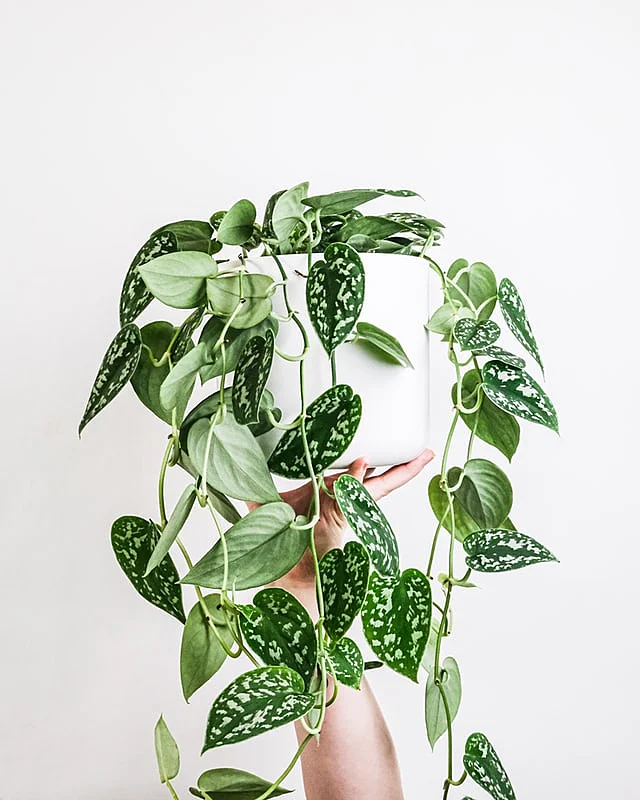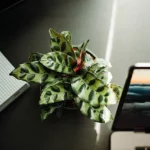Table of Contents
Caring for Scindapsus Pictus
Scindapsus Pictus, also known as a Satin Pothos or Silver Pothos, is a common houseplant that originated in Southeast Asia.
It’s one of the easier houseplants to keep alive, and its coloring and vines make it a striking hanging or climbing plant to keep on display.
Scindapsus Pictus is an evergreen plant, which means that, if taken care of, this plant stays green and vibrant all year long. It has heart-shaped leaves, and the coloring of the silvery spots gives the leaves a silky or satiny sheen.
Helping Scindapsus Pictus Thrive
As with any plant, Scindapsus Pictus has certain conditions under which it does best, including particular lighting and temperatures. It is one of the more forgiving houseplants if conditions are a little less than ideal, with exceptions noted below.
This plant’s growth speed is typically not a major indicator of problems. Its leaves, however, are a good way to quickly judge whether or not the plant is happy and healthy.
A Scindapsus Pictus in good condition will have dark green leaves that are covered in silvery spots that almost appear painted on.
Some variants also feature a silvery border around the edges of the leaves. Yellow or brown are indications that the plant needs a change in its environment or to have pests removed.
Light Requirements
Bright, indirect light is best for Scindapsus Pictus. If there isn’t enough light, the leaves lose their vibrancy. If the sunlight is too direct, the leaves tend to turn brown and dry, especially at their tips (note: this can also be caused by dry air).
Try putting Scindapsus Pictus in a bright room, but not too close to a window that gets direct sun.
If you have to choose between too direct or too little sunlight, Scindapsus Pictus does better in lower light. It will likely lose a lot of its distinct coloring, but it’s less likely to suffer actual harm.
Temperature Requirements
Scindapsus Pictus is very particular about temperature. It does not do well in cold weather, with a minimum recommended temperature around 59 degrees Fahrenheit. This is part of the reason it does so well indoors, where it’s not likely to be exposed to a sudden frost.
Being a tropical plant, it’s much more tolerant to warmer temperatures, and it’s fine up to around 85 degrees.
Brief variations in temperature are more likely to be harmful if they’re too cold than too hot, so err on the side of caution in keeping this plant from getting chilled.
Soil Requirements
Scindapsus Pictus does well with an all-purpose potting mix and doesn’t have any specific requirements.
Humidity Requirements
Scindapsus Pictus does best with average or high humidity. If you live in a relatively humid area, it’s likely fine with the air as it is. If you live in a dry area or if you get dry winters, you may want to consider using a humidifier.
How to Water
Water Scindapsus Pictus once every week or two using room temperature water. Be sure that the pot has sufficient drainage. Make sure the soil is moist when watered, but you’ll typically want at least the top inch or two of soil to dry out in between waterings.
If the leaves start turning yellow, then it’s getting watered too frequently or retaining too much water in the soil. Despite the fact that it likes humidity, this plant does better if it’s a little underwatered than if it’s overwatered.
Try not to get the leaves wet when watering. If the leaves start to develop brown spots, that can indicate bacterial leaf spots. To treat this, the affected leaves should be cut off. It’s better to avoid the excess or misplaced water in the first place, if possible.
How to Fertilize
This plant does best with a balanced, water-soluble fertilizer applied from spring through fall. These are easy to find at any store that sells plant supplies, and they’re simply added monthly during seasons of growth.
Pruning
Pruning isn’t necessary in order to encourage growth of Scindapsus Pictus. However, it won’t hurt it, either, if you use pruning to keep the growth under control.
The vines can reach a few feet of length indoors, so they may not fit as intended without some pruning, depending how much space you have available.
Propagation
To grow another Scindapsus Pictus, take a 4″ cutting in spring or summer. Plant this in moist soil. It should take root in about a month. Cuttings can also be started off in water.
Scindapsus Pictus grows best when it has space for the vines to grow away from the roots, either upward along a stake or downward over the edges of a hanging basket. This way, the vines don’t overcrowd the plant.
Pests and Diseases
Scindapsus Pictus isn’t terribly prone to either pests or diseases. It can occasionally get mites or scale bugs.
Ridding Scindapsus Pictus of Mites
Gently wipe down the plant to rid it of any visible bugs and clear any webs or anything else that might lead to recurrence of mites. Then, either use a store-bought pesticide (there are ones specifically for dealing with mites), or use a natural repellant.
Neem oil is recommended frequently, as it deters pests and gives leaves a nice sheen.
It’s also a good idea to treat any nearby plants, since mite infestations often go unnoticed until they’re fairly significant.
Ridding Scindapsus Pictus of Scale
Scale bugs, or just Scale, look a bit like fish scale and are fairly common plant parasites. Similar to with mites, you’ll want to start by gently wiping or scraping off any visible Scale. Then, use an insecticidal soap or spray to discourage re-infestation.
Safety
As with many houseplants, Scindapsus Pictus should be kept away from household pets and children. It has no thorns or other hazards as long as it isn’t ingested.
Quick Reference
- Light: Bright & indirect
- Temperature: 59 to 85 degrees Fahrenheit
- Soil: Dry to slightly moist. Standard potting soil
- Humidity: Average to high
- Water: Every 1-2 weeks
- Pruning: As needed for space and aesthetics
Photo by Severin Candrian on Unsplash


